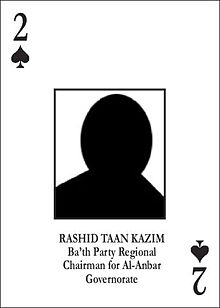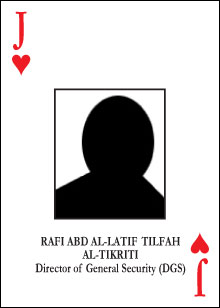Most-wanted Iraqi playing cards
In the 2003 invasion of Iraq by a United States-led coalition, the U.S. military developed a set of playing cards to help troops identify the most-wanted members of President Saddam Hussein's government, mostly high-ranking members of the Iraqi Regional Branch of the Arab Socialist Ba'ath Party or members of the Revolutionary Command Council. The cards were officially named the "personality identification playing cards".
About the cards
Each card contains the wanted person's address and, if available, the job performed by that individual. The highest-ranking cards, starting with the aces and kings, were used for the people at the top of the most-wanted list. The ace of spades is Saddam Hussein, the aces of clubs and hearts are his sons Qusay and Uday respectively, and the ace of diamonds is Saddam's presidential secretary Abid Hamid Mahmud al-Tikriti. This strict correspondence to the order of the most-wanted list was not carried through the entire deck, but some time later in 2003, the list itself was renumbered to conform (almost) to the deck of cards. The card backs feature a green military camouflage pattern.
According to Navy Lt. Cmdr. Jim Brooks, a spokesman for the Defense Intelligence Agency, such playing cards have been used as far back as the Civil War and again in World War II - Army Air Corps decks printed with the silhouettes of German and Japanese fighter aircraft fetch hundreds of dollars today - and in the Korean War. Troops often play cards to pass the time, and seeing the names, faces and titles of the wanted Iraqis during their games will help soldiers and Marines in case they run into the wanted individuals in the field, Brooks said.
The list of "Most Wanted" was the result of a multi-intelligence agency collaboration which included the Defense Intelligence Agency, Central Command, and representatives from all US Service Branch Intelligence entities. The "Most Wanted" names were then assigned to their respective cards by five US Army soldiers, 2LT Hans Mumm, SSG Shawn Mahoney, SGT Andrei Salter, SGT Scott Boehmler, and SPC Joseph Barrios, who were assigned to the Defense Intelligence Agency. The pictures used on the cards came from a number of intelligence agencies, but most were derived from "open sources". The deck of cards was first announced publicly in Iraq on 11 April 2003, in a press conference by Army Brig. Gen. Vincent Brooks, deputy director of operations at U.S. Central Command. On that same evening Max Hodges, a Houston-based entrepreneur, found and downloaded a high-resolution artwork file for the deck from a Defense Department web server. Discovering the following day that the file had vanished from the military web server he became the first eBay seller to offer the artwork file, in PDF, which could be used to reproduce the deck. He quickly contracted Gemaco Playing Card Company to print 1,000 decks for about $4,000 and started selling both the decks, in advance of receiving them from the printer, on eBay, Amazon.com and his own web site. When some of his early auctions for a $4 deck of cards quickly rose to over $120, it did not take long for other eBayers to jump on the bandwagon and print or order decks of their own to sell. In just a few days hundreds of sellers materialized and the price dropped to just a few dollars per deck.
Texas-based Liberty Playing Card Co. received an order to manufacture the cards for the U.S. Embassy in Kuwait and by claiming to be "the authorized government contractor" quickly became another popular domestic supplier for the commercial market. The U.S. military inadvertently included in the jokers the trademarked Hoyle joker owned by the United States Playing Card Company of Cincinnati, Ohio. Although The U.S. Playing Card company does not object to the government's use of the image, they do object to other companies using the trademarked image. Thus, in some sense, the U.S. military inadvertently granted The U.S. Playing Card Company exclusive rights to manufacture the authentic decks, if the trademarked images on the jokers are considered a requirement for being authentic.
Spades

Rashid Taan Kazim playing card
- Ace ♠: Saddam Hussein, president (#1 on most-wanted list) (Executed 2006).
- King ♠: Ali Hassan al-Majid, also known as Chemical Ali (#5) (Executed 2010).
- Queen ♠: Muhammad Hamza Zubaydi, retired RCC member (#9, but was originally #18) (Died in Custody 2005).
- Jack ♠: Ibrahim Ahmad Abd al-Sattar Muhammad, Iraqi armed forces chief of staff (#13, was #11) (Died in Custody 2010).
- Ten ♠: Hamid Raja Shalah, Air Force commander (#17, was #15) (Captured 2005).
- Nine ♠: Rukan Razuki Abd Al-Ghafar Sulayman Al-Majid, head of tribal affairs office (#21, was #39) (Killed in 2003).
- Eight ♠: Tariq Aziz, deputy prime minister (#25, was #43) (Surrendered 2003 and sentenced to death, Died in June 2015).
- Seven ♠: Mahmud Dhiyab, minister of interior (#29, was #46) (Surrendered 2003, Released in July 2012).
- Six ♠: Amir Rashid Muhammad al-Ubaydi, presidential adviser/former oil minister (#33, was #47) (Surrendered 2003, Released in April 2012).
- Five ♠: Watban Ibrahim Hasan, presidential adviser (#37, was #51) (Captured 2003, Sentenced to Death).
- Four ♠: Muhammad Zimam Abd al-Razzaq, Ba'ath Party branch command chairman (#41, was #23)
- Three ♠: Sa'd Abdul-Majid Al-Faisal, Ba'ath Party branch command chairman (#55, was #36)
- Two ♠: Rashid Taan Kazim, Ba'ath Party regional chairman (#49, was #30).
Clubs
- Ace ♣: Qusay Saddam Husayn, son of Saddam (#2), killed in standoff with the U.S. Army in Mosul, Iraq 2003.
- King ♣: Izzat Ibrahim al-Douri, RCC vice chairman (#6), allegedly died in April, 2015.
- Queen ♣: Kamal Mustafa Abdallah Sultan, secretary of the Republican Guard (#10, was #8).
- Jack ♣: Sayf Al-Din Fulayyih Hasan Taha Al-Rawi, Republican Guard chief of staff (#14, was #12).
- Ten ♣: Latif Nusayyif Jasim, Ba'ath Party military bureau deputy chairman (#18, was #37).
- Nine ♣: Jamal Mustafa Abdallah Sultan, deputy head of tribal affairs (#22, was #40).
- Eight ♣: Walid Hamid Tawfiq, governor of Basra (#26, was #44).
- Seven ♣: Ayad Futayyih Khalifa al-Rawi, Quds forces chief of staff (#30, was #20).
- Six ♣: Husam Muhammad Amin, head of National Monitoring Directorate (#34, was #49) (Released 2005).
- Five ♣: Barzan Ibrahim Hasan, presidential adviser (#38, was #52) (Executed 2007).
- Four ♣: Samir Abd Al-Aziz, Ba'ath Party branch command chairman (#42, was #24). (Captured 2003)
- Three ♣: Sayf al-Din Al-Mashhadani, Ba'ath Party branch command chairman (#46, was #27).
- Two ♣: Ugla Abid Saqr, Ba'ath Party regional chairman (#50, was #31).
Hearts

Rafi Abd Al-Latif Tilfah playing card
- Ace ♥: Uday Saddam Husayn, son of Saddam Hussein, killed in standoff with US Army in Mosul, Iraq 2003 (#3).
- King ♥: Hani Abd al-Latif Tilfah, Director - special security organization (#7). (Captured in 2004)
- Queen ♥: Barzan Abd al-Ghafur Sulayman Majid, Special Republican Guard commander (#11, was #9).
- Jack ♥: Rafi Abd Al-Latif Tilfah, director of general security (#15, was #13).
- Ten ♥: Abd Al-Tawab Mullah Huwaysh, deputy prime minister (#19, was #16).
- Nine ♥: Mizban Khadr Hadi, RCC member (#23, was #41).
- Eight ♥: Sultan Hashim Ahmad, minister of defense (#27, was #19) (Captured 2003, Sentenced to Death).
- Seven ♥: Zuhayr Talib Abd Al-Sattar, director of military intelligence (#31, was #21).
- Six ♥: Muhammad Mahdi (#35, was #48).
- Five ♥: Huda Salih Mahdi Ammash, weapons of mass destruction scientist (known as "Mrs. Anthrax"; No. 39, was #53; also the only female on the entire list) (Released 2005).
- Four ♥: Humam Abd Al-Khaliq Abd, minister of higher education and scientific research (#43, was #54).
- Three ♥: Fadil Mahmud Gharib, Ba'ath Party branch command chairman (#47, was #28).
- Two ♥: Ghazi Hammud, Ba'ath Party branch command chairman (#51, was #32).
Diamonds
- Ace ♦: Abid Hamid Mahmud, presidential secretary (#4), executed on 7 June 2012.
- King ♦: Aziz Salih, Ba'ath Party branch command chairman (#8, was #17, sentenced to death in 2011).
- Queen ♦: Muzahim Sa'b Hassan al-Tikriti, air defense forces commander (#12, was #10) (Captured 2003, Released in April 2012).
- Jack ♦: Tahir Jalil Habbush, Iraqi intelligence service (#16, was #14).
- Ten ♦: Taha Yasin Ramadan, vice president/RCC member (executed in 2007; #20, was #38).
- Nine ♦: Taha Muhyi Al-Din Maruf, vice president/RCC member (#24, was #42, died in exile in 2009).
- Eight ♦: Hikmat Mizban Ibrahim, deputy prime minister and finance minister (#28, was No. 45 - Died in Custody 2012).
- Seven ♦: Amir Hamudi Hasan, presidential scientific adviser (#32, was #55).
- Six ♦: Sabawi Ibrahim Hasan, presidential adviser (#36, was #50- Died of cancer in 2013).
- Five ♦: Abd al-Baqi Abd al-Karim Abdallah, Ba'ath Party branch command chairman (#40, was #22 - Captured in 2015).
- Four ♦: Yahya Abdallah, Ba'ath Party branch command chairman (#44, was #25), (Killed in 2003).
- Three ♦: Muhsin Khadr, Ba'ath Party branch command chairman (#48, was #29).
- Two ♦: Adil Abdallah Mahdi, Ba'ath Party branch command chairman (#52, was #33).
Other
There are also two jokers: one lists Arab titles, the other Iraqi military ranks. There are no cards for most-wanted No. 45 (was #26), Nayif Shindakh Thamir, No. 53 (was #34 - Killed in 2003) Husayn al-Awadi, or No. 54 (was #35) Khamis Sirhan al-Muhammad, although knight cards could be used for this purpose, but in this case the whole deck would be rearranged. Khamis Sirhan al-Muhammad was captured in January 2004 and held without charge for six years before being released on 30 July 2010. He has since fled to Syria where most of the other 6 uncaptured members of the deck of cards are reported to be hiding.
The 13 June 2003 edition of the BBC One satirical news quiz, Have I Got News for You, featured a set of the playing cards in one round, spoofing guest host Bruce Forsyth's 1980s game show Play Your Cards Right (the British version of the American series Card Sharks). The two teams played a version of the latter's main game, retitled Play Your Iraqi Cards Right (although during the segment it was revealed that the writers' first choice had been Play Your Kurds Right), with the same rules (and audience participation). Much of the humour of the round came from the reactions of the two team captains: while Paul Merton was clearly familiar with the game and greatly enjoyed it, his opponent, Ian Hislop, admitted he'd never seen Play Your Cards Right and appeared mystified by the game's rules and etiquette (when at one point Merton and the crowd shouted the traditional cry of "lower, lower," to predict the next card in the hidden sequence, Hislop commented, "I'm not sure this programme could get much lower!")
Read more:
Sources
- Brigadier General Vincent Brooks introduces Iraqi cards at CentComm press conference in Doha, Qatar, 11 April 2003.
- "Troops Dealt an Old Tool" by Tom Zucco, St. Petersburg Times, 12 April 2003.
- Personality Identification Playing Cards
- "Card-Carrying Civilians", Time Magazine, 12 May 2003, page 25.
- Brigadier General Vincent Brooks introduced the first set of Iraqi freedom cards, 11 April 2003
- Card Makers Producing 'Most-Wanted' Decks: Company Warns Others About 'Joker' Image, 23 April 2003, ClickOnDetroit.com.
- Iraqi Most Wanted Scorecard
COMMENTS








 Rashid Taan Kazim playing card
Rashid Taan Kazim playing card Rafi Abd Al-Latif Tilfah playing card
Rafi Abd Al-Latif Tilfah playing card